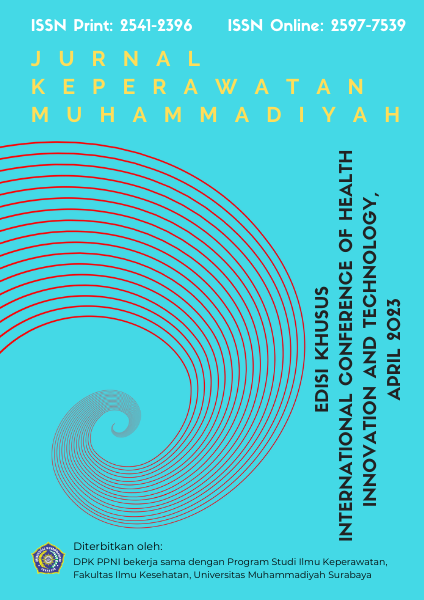THE MODEL OF VIRTUAL NURSING CARE FOR FUTURISTIC CHALLENGE: A LITERATURE REVIEW
DOI:
https://doi.org/10.30651/jkm.v0i0.17875Keywords:
Information Technology, Patient Quality of Care, Virtual Care NursingAbstract
Objective: To provide an understanding and summarize the challenge regarding the need to be prepared for performing virtual care .
Methods: This literature review was conducted through searching 5 databases including ProQuest, Science Direct, PubMed, SAGE, and Google Scholar were searched to identify relevant articles. The strategy used in searching for literature that matches the topic in this literature review uses the PICO framework and then a review was carried out using the PRISMA method to gain insight intothe virtual care nurses.
Results: Eight studies met the inclusion out of 45 searchresults. Currently, Virtual nursing care delivery is an innovative strategy to improve patient quality of care. This strategy refers to a variety of healthcare activities delivered remotely using telecommunications and other technologies and this service requires an organized change on nursing management process.
Conclusion: Educational preparation includes telenursing as one of the models of nursing care in the nursing education curriculum, developing standards of practice, and certification for Tele nurses to assure patient safety and quality patient outcomes.
Â
References
Arnaert, Antonia, Alice Girard, Stephanie Craciunas, Zhida Shang, Hamza Ahmad, Zoumanan Debe, and Sebastian Demyttenaere. 2022. “Patients’ Experiences of Telenursing Follow- up Care after Bariatric Surgery.†Journal of Clinical Nursing 31(7–8):985–94. doi: 10.1111/jocn.15955.
Castner, Jessica, Sue Anne Bell, Breanna Hetland, Claudia Der-Martirosian, Martin Castner, and Aditi U. Joshi. 2022. “National Estimates of Workplace Telehealth Use Among Emergency Nurses and All Registered Nurses in the United States.†Journal of EmergencyNursing 48(1):45–56. doi: 10.1016/j.jen.2021.07.001.
Cloyd, Beth, and Julia Thompson. 2020. “Virtual Care Nursing:: The Wave of the Future.â€
Nurse Leader 18(2):147–50. doi:
1016/j.mnl.2019.12.006.
Firouzkouhi, Mohammadreza, Abdolghani
Abdollahimohammad, Judie Arulappan, Taha Nouraei, and Jebraeil Farzi. 2021. “Challenges and Opportunities of Using Telenursing During COVID-19 Pandemic: An Integrative Review.†Frontiers in Health Informatics 10(1):98. doi: 10.30699/fhi.v10i1.332.
KIC, 2022. Survei: Konsumen Makin Nyaman Menggunakan Layanan Telemedik, s.l.: Kata Data.
Mattison, M. & Arestedt, K., 2022. Role of Interaction of Caller Satisfaction in Telenursing: A Cross Sectional Study. Clinical Nursing Wiley, pp. 1-10.
Meitri, W. & Herawati, T., 2022. Efektivitas Telenursing terhadap Fungsi Lutut Pasien Post Total Knee Arthroplasty. Journal of Health and Cardiovascular Nursing.
Raesi, Rasoul, Zahra Abbasi Shaye, Sam Saghari, Mohammad Ali Sheikh Beig Goharrizi, Mehdi Raei, and Kiavash Hushmandi. 2021. “The Impact of Education through Nurse-Led Telephone Follow-up (Telenursing) on the Quality of Life of
Rim,
COVID-19 Patients.†Journal of the Egyptian Public Health Association 96(1). doi: 10.1186/s42506-021- 00093-y.
Dahae, and Hyunsook Shin. 2022. “Development and Assessment of a Multi- User Virtual Environment Nursing Simulation Program: A Mixed Methods Research Study.†Clinical Simulation in Nursing 62(2003):31–41. doi: 10.1016/j.ecns.2021.10.004.
Jurnal Keperawatan Muhammadiyah Edisi Khusus ICHIT 2023
Rutledge, C., Gustin & Tina, 2021. Preparing Nurses for Roles in Telehealth: Now is The Time.
The Online Journal of Issues in Nursing. Sudirman, A., 2022. Information Technology: Konsep dan Implementasinya. 1 ed.
Bandung: Media Sains Indonesia.
Downloads
Published
Issue
Section
License
- Penulis tetap memegang hak atas karyanya dan memberikan hak publikasi pertama kepada jurnal ini yang secara simultan karya tersebut dilisensikan di bawah:Â Creative Commons Attribution-ShareAlike 4.0 International (CC BY-SA 4.0)













